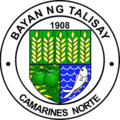Top Qs
Timeline
Chat
Perspective
Talisay, Camarines Norte
Municipality in Camarines Norte, Philippines From Wikipedia, the free encyclopedia
Remove ads
Talisay, officially the Municipality of Talisay (Tagalog: Bayan ng Talisay), is a municipality in the province of Camarines Norte, Philippines. According to the 2020 census, it has a population of 27,244 people.[3]
Remove ads
The fertile soil, topography (averaging about 10 metres (33 ft) above sea-level) and suitable climate are the main reasons why agriculture is the economic backbone of the town. Rice and coconut farming are the major agricultural activities for most of the barangays and fishing is the second thriving industry particularly in the coastal barangays.
Talisay has programs and facilities for education. The municipality created successful professionals in various fields such as medicine, law, engineering, architecture, education, law enforcement and military service, banking, business, sports, entertainment, marketing, etc. The incumbent mayor is Dondon Mancenido.
The municipality holds singing and dance competitions throughout the year usually held at the public plaza. Talisay is 4 kilometres (2.5 mi) from Daet and 338 kilometres (210 mi) from Manila.
Remove ads
History
Summarize
Perspective
The history of Talisay, Camarines Norte, is closely linked to early Spanish missionary efforts in the region. Initially known as "Tarisay," the town was established as a visita (a satellite settlement) under Daet in 1654. This period marked the expansion of Franciscan missionaries, who had arrived in Daet in 1583 to spread Christianity across the Bicol region.
Spanish Colonial Period (16th–19th Century)
By the late 16th and early 17th centuries, Talisay was under the ecclesiastical jurisdiction of the Franciscans. However, due to a shortage of clergy, Daet and its visitas—including Talisay—struggled to maintain consistent religious leadership. By the mid-17th century, the administration of these areas was transferred from the Franciscan order to the secular clergy.
During this period, Talisay continued to grow while remaining tied to the Spanish colonial structure. The town primarily thrived through rice cultivation, which became its major economic activity. By the 19th century, Talisay had developed into a more established settlement, mirroring the urbanization trends of Daet and other nearby communities.
The Naming of Talisay
Local tradition attributes the name "Talisay" (or "Tarisay") to an encounter between Spanish explorers and a native resident. While searching for gold in the area, the Spaniards asked a local for the name of the place. Misunderstanding the question, the local responded "Talisay", referring to a type of tree abundant in the area. The Spaniards adopted the name, and it has remained ever since.
World War II and Historical Landmarks
Talisay played a role during World War II, with local resistance movements fighting against Japanese forces. Today, a small memorial in town stands in honor of its World War II veterans and heroes.
Another notable historical site is the St. Francis of Assisi Parish Church, which dates back to the Spanish period. Due to its age and traditional construction, it serves as a landmark reflecting the town’s colonial past.
Modern Talisay
Today, Talisay continues to be known for its agricultural contributions, particularly rice production. While it has grown into a distinct community over the centuries, its history remains deeply intertwined with Spanish missionary efforts, colonial governance, and the resilience of its people.
Remove ads
Geography
Summarize
Perspective
Talisay is a landlocked municipality located in Camarines Norte, within the Bicol Region of the Philippines. Talisay is bordered by Vinzons to the northwest, Daet to the southeast, and San Vicente to the southwest. While it is near coastal towns like Vinzons and Mercedes. While it is near coastal towns, Talisay itself is primarily an agricultural community rather than a coastal one.
The town’s topography is mostly flat, with some gently rolling hills in the inland areas. Rice fields dominate the landscape, reflecting its agricultural economy, while rivers and waterways provide essential irrigation. Unlike its neighboring municipalities, which have direct access to the sea, Talisay's economy is centered around farming rather than fishing.
Talisay has a tropical monsoon climate, characterized by heavy rainfall from June to December and a dry season from January to May. As part of the Pacific typhoon belt, it is vulnerable to strong storms and floods, which can affect farming and infrastructure. Despite these challenges, the town remains resilient, with its agriculture playing a crucial role in sustaining its local economy.
With its rich farmlands and strong farming traditions, Talisay thrives as a rural agricultural town. The Paruyan Festival serves as a testament to its deep connection to rice farming, reinforcing its identity as one of the province’s key agricultural communities.
Barangay
Talisay is politically subdivided into 15 barangays. Each barangay consists of puroks and some have sitios.
- Binanuaan
- Caawigan
- Cahabaan
- Calintaan
- Del Carmen
- Gabon
- Itomang
- Poblacion
- San Francisco
- San Isidro
- San Jose
- San Nicolas
- Santa Cruz
- Santa Elena
- Santo Niño
Climate
Remove ads
Demographics
In the 2020 census, the population of Talisay, Camarines Norte, was 27,244 people,[3] with a density of 890 inhabitants per square kilometre or 2,300 inhabitants per square mile.
Economy
Poverty incidence of Talisay
10
20
30
40
2000
32.09 2003
30.51 2006
32.10 2009
28.61 2012
17.88 2015
26.73 2018
24.46 2021
14.24 Source: Philippine Statistics Authority[10][11][12][13][14][15][16][17] |
Just a neighboring town of Daet, Talisay is often seen as a suburb of Daet due to its proximity to the town. Many warehouses have opened in the town.
References
External links
Wikiwand - on
Seamless Wikipedia browsing. On steroids.
Remove ads





